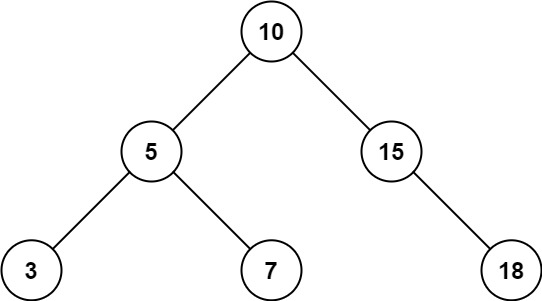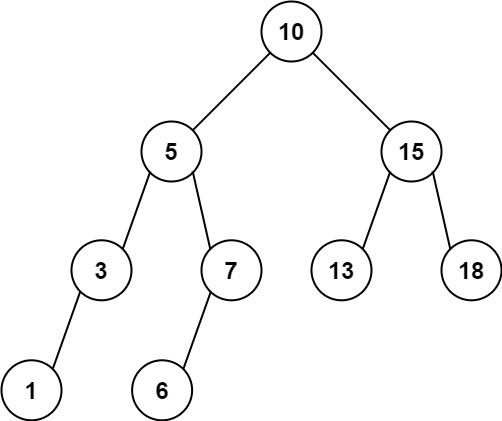算法leetcode每日一练二叉搜索树的范围和
Posted 二当家的白帽子
tags:
篇首语:本文由小常识网(cha138.com)小编为大家整理,主要介绍了算法leetcode每日一练二叉搜索树的范围和相关的知识,希望对你有一定的参考价值。
文章目录
二叉搜索树的范围和:
给定二叉搜索树的根结点 root,返回值位于范围 [low, high] 之间的所有结点的值的和。
样例 1:

输入:
root = [10,5,15,3,7,null,18], low = 7, high = 15
输出:
32
样例 2:

输入:
root = [10,5,15,3,7,13,18,1,null,6], low = 6, high = 10
输出:
23
提示:
- 树中节点数目在范围 [1, 2 * 1 0 4 10^4 104] 内
- 1 <= Node.val <= 1 0 5 10^5 105
- 1 <= low <= high <= 1 0 5 10^5 105
- 所有 Node.val 互不相同
分析
- 面对这道算法题目,二当家的陷入了沉思。
- 遍历二叉搜索树是必然的,递归是最直观的方式。
题解
java
/**
* Definition for a binary tree node.
* public class TreeNode
* int val;
* TreeNode left;
* TreeNode right;
* TreeNode()
* TreeNode(int val) this.val = val;
* TreeNode(int val, TreeNode left, TreeNode right)
* this.val = val;
* this.left = left;
* this.right = right;
*
*
*/
class Solution
public int rangeSumBST(TreeNode root, int low, int high)
if (root == null)
return 0;
int val;
if (root.val >= low
&& root.val <= high)
// 根结点符合条件
val = root.val;
else
val = 0;
int leftVal;
if (root.val > low)
// 左子树可能大于等于low
leftVal = rangeSumBST(root.left, low, high);
else
leftVal = 0;
int rightVal;
if (root.val < high)
// 右子树可能小于等于high
rightVal = rangeSumBST(root.right, low, high);
else
rightVal = 0;
return val + leftVal + rightVal;
c
/**
* Definition for a binary tree node.
* struct TreeNode
* int val;
* struct TreeNode *left;
* struct TreeNode *right;
* ;
*/
int rangeSumBST(struct TreeNode* root, int low, int high)
if (root == NULL)
return 0;
int val;
if (root->val >= low
&& root->val <= high)
// 根结点符合条件
val = root->val;
else
val = 0;
int leftVal;
if (root->val > low)
// 左子树可能大于等于low
leftVal = rangeSumBST(root->left, low, high);
else
leftVal = 0;
int rightVal;
if (root->val < high)
// 右子树可能小于等于high
rightVal = rangeSumBST(root->right, low, high);
else
rightVal = 0;
return val + leftVal + rightVal;
c++
/**
* Definition for a binary tree node.
* struct TreeNode
* int val;
* TreeNode *left;
* TreeNode *right;
* TreeNode() : val(0), left(nullptr), right(nullptr)
* TreeNode(int x) : val(x), left(nullptr), right(nullptr)
* TreeNode(int x, TreeNode *left, TreeNode *right) : val(x), left(left), right(right)
* ;
*/
class Solution
public:
int rangeSumBST(TreeNode* root, int low, int high)
if (root == nullptr)
return 0;
int val;
if (root->val >= low
&& root->val <= high)
// 根结点符合条件
val = root->val;
else
val = 0;
int leftVal;
if (root->val > low)
// 左子树节点可能大于等于low
leftVal = rangeSumBST(root->left, low, high);
else
leftVal = 0;
int rightVal;
if (root->val < high)
// 右子树节点可能小于等于high
rightVal = rangeSumBST(root->right, low, high);
else
rightVal = 0;
return val + leftVal + rightVal;
;
python
# Definition for a binary tree node.
# class TreeNode:
# def __init__(self, val=0, left=None, right=None):
# self.val = val
# self.left = left
# self.right = right
class Solution:
def rangeSumBST(self, root: TreeNode, low: int, high: int) -> int:
if root is None:
return 0
val = 0
if root.val >= low and root.val <= high:
# 根结点符合条件
val = root.val
left_val = 0
if root.val > low:
# 左子树可能大于等于low
left_val = self.rangeSumBST(root.left, low, high)
right_val = 0
if root.val < high:
# 右子树可能小于等于high
right_val = self.rangeSumBST(root.right, low, high)
return val + left_val + right_val
go
/**
* Definition for a binary tree node.
* type TreeNode struct
* Val int
* Left *TreeNode
* Right *TreeNode
*
*/
func rangeSumBST(root *TreeNode, low int, high int) int
if root == nil
return 0
val := 0
if root.Val >= low && root.Val <= high
// 根结点符合条件
val = root.Val
leftVal := 0
if root.Val > low
// 左子树可能大于等于low
leftVal = rangeSumBST(root.Left, low, high)
rightVal := 0
if root.Val < high
// 右子树可能小于等于high
rightVal = rangeSumBST(root.Right, low, high)
return val + leftVal + rightVal
rust
// Definition for a binary tree node.
// #[derive(Debug, PartialEq, Eq)]
// pub struct TreeNode
// pub val: i32,
// pub left: Option<Rc<RefCell<TreeNode>>>,
// pub right: Option<Rc<RefCell<TreeNode>>>,
//
//
// impl TreeNode
// #[inline]
// pub fn new(val: i32) -> Self
// TreeNode
// val,
// left: None,
// right: None
//
//
//
use std::rc::Rc;
use std::cell::RefCell;
impl Solution
pub fn range_sum_bst(root: Option<Rc<RefCell<TreeNode>>>, low: i32, high: i32) -> i32
match root
Some(root) =>
let mut root = root.borrow_mut();
let val = if root.val >= low && root.val <= high
root.val
else
0
;
let leftVal = if root.val > low
Self::range_sum_bst(root.left.take(), low, high)
else
0
;
let rightVal = if root.val < high
Self::range_sum_bst(root.right.take(), low, high)
else
0
;
val + leftVal + rightVal
,
_ => 0
typescript
/**
* Definition for a binary tree node.
* class TreeNode
* val: number
* left: TreeNode | null
* right: TreeNode | null
* constructor(val?: number, left?: TreeNode | null, right?: TreeNode | null)
* this.val = (val===undefined ? 0 : val)
* this.left = (left===undefined ? null : left)
* this.right = (right===undefined ? null : right)
*
*
*/
function rangeSumBST(root: TreeNode | null, low: number, high: number): number
if (!root)
return 0;
let val = 0;
if (root.val >= low && root.val <= high)
// 根结点符合条件
val = root.val;
let leftVal = 0
if (root.val > low)
// 左子树可能大于等于low
leftVal = rangeSumBST(root.left, low, high);
let rightVal = 0;
if (root.val < high)
// 右子树可能小于等于high
rightVal = rangeSumBST(root.right, low, high);
return val + leftVal + rightVal;
;
原题传送门:https://leetcode-cn.com/problems/range-sum-of-bst/
非常感谢你阅读本文~
欢迎【👍点赞】【⭐收藏】【📝评论】~
放弃不难,但坚持一定很酷~
希望我们大家都能每天进步一点点~
本文由 二当家的白帽子:https://le-yi.blog.csdn.net/ 博客原创~
以上是关于算法leetcode每日一练二叉搜索树的范围和的主要内容,如果未能解决你的问题,请参考以下文章
算法leetcode每日一练2265. 统计值等于子树平均值的节点数